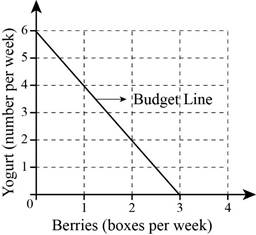
Consumer preferences and budget line.
Explanation of Solution
It is given that the total income of J is $12. The
Assume J had spent his entire income to buy yogurt. The total quantity of yogurt consumed can be calculated by substituting the respective values in Equation (1).
The quantity of yogurt consumed is 6 and the quantity of berries consumed is 0.
Similarly when the entire income is spent on the consumption of berries, the quantity can be calculated by substituting the respective values in Equation (1).
The quantity of berries consumed is 3 and the quantity of yogurt consumed is 0.
Table 1 shows the various combinations of yogurt and berries that can be bought with the given income that was obtained using Equation (1).
Table 1
| Quantity of Yogurt | 6 | 4 | 2 | 0 |
| Quantity of Berries | 0 | 1 | 2 | 3 |
Figure 1 shows the budget line of J.

The horizontal axis of Figure 1 measures the quantity of berries and the vertical axis measures the quantity of Yogurt. The budget line touches the vertical axis when the entire income is used to consume 6 units of yogurt and the horizontal axis when the entire income is spent on consuming berries. Each point on budget line shows various combination of consuming yogurt and berries by spending the whole income.
Budget line: Budget line refers to all the possible combinations of goods and services that can be purchased with the entire income, at a given price level.
Want to see more full solutions like this?
Chapter 8 Solutions
Microeconomics (12th Edition) (Pearson Series in Economics)
- As indicated in the attached image, U.S. earnings for high- and low-skill workers as measured by educational attainment began diverging in the 1980s. The remaining questions in this problem set use the model for the labor market developed in class to walk through potential explanations for this trend. 1. Assume that there are just two types of workers, low- and high-skill. As a result, there are two labor markets: supply and demand for low-skill workers and supply and demand for high-skill workers. Using two carefully drawn labor-market figures, show that an increase in the demand for high skill workers can explain an increase in the relative wage of high-skill workers. 2. Using the same assumptions as in the previous question, use two carefully drawn labor-market figures to show that an increase in the supply of low-skill workers can explain an increase in the relative wage of high-skill workers.arrow_forwardPublished in 1980, the book Free to Choose discusses how economists Milton Friedman and Rose Friedman proposed a one-sided view of the benefits of a voucher system. However, there are other economists who disagree about the potential effects of a voucher system.arrow_forwardThe following diagram illustrates the demand and marginal revenue curves facing a monopoly in an industry with no economies or diseconomies of scale. In the short and long run, MC = ATC. a. Calculate the values of profit, consumer surplus, and deadweight loss, and illustrate these on the graph. b. Repeat the calculations in part a, but now assume the monopoly is able to practice perfect price discrimination.arrow_forward
- how commond economies relate to principle Of Economics ?arrow_forwardCritically analyse the five (5) characteristics of Ubuntu and provide examples of how they apply to the National Health Insurance (NHI) in South Africa.arrow_forwardCritically analyse the five (5) characteristics of Ubuntu and provide examples of how they apply to the National Health Insurance (NHI) in South Africa.arrow_forward
 Economics Today and Tomorrow, Student EditionEconomicsISBN:9780078747663Author:McGraw-HillPublisher:Glencoe/McGraw-Hill School Pub Co
Economics Today and Tomorrow, Student EditionEconomicsISBN:9780078747663Author:McGraw-HillPublisher:Glencoe/McGraw-Hill School Pub Co

 Economics (MindTap Course List)EconomicsISBN:9781337617383Author:Roger A. ArnoldPublisher:Cengage Learning
Economics (MindTap Course List)EconomicsISBN:9781337617383Author:Roger A. ArnoldPublisher:Cengage Learning
 Principles of MicroeconomicsEconomicsISBN:9781305156050Author:N. Gregory MankiwPublisher:Cengage Learning
Principles of MicroeconomicsEconomicsISBN:9781305156050Author:N. Gregory MankiwPublisher:Cengage Learning





